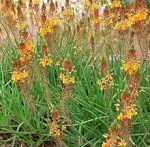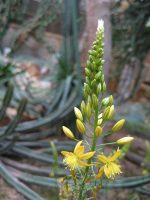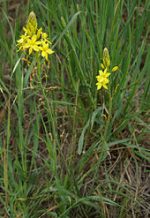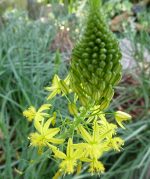
Bulbine is a genus of succulent shrubs, tender perennials, and annuals and a member of the Asphodelaceae family that also includes aloe, tritoma, and foxtail lily. It is native to Southern and tropical Africa, Australia, and Yemen but is especially valued as a garden plant elsewhere for its tolerance of heat and drought. Plants grow from a tuberous root and have long, linear to lanceolate leaves. The small starry, 6-tepaled flowers open from bottom up on a tall, slender scape in lax or compound tapering racemes in late winter to late spring. They are usually yellow but can be white, orange or pink and have densely bearded stamen filaments. The generic name, Bulbine, comes from the Greek word bolbos, meaning bulb and mistakenly refers to the reproductive structure of the plant which is actually a corm.
Bulbines like full sun, and average, well-drained soil but tolerate lean soil and some shade. They go dormant from late spring to autumn but timing varies with the species. Propagated is by seed, separation of offsets, or cuttings, and self-seeding is common. Dead-head to prevent self-seeding and maintain appearance. Plans can be used in borders, as ground covers, and in containers.
Bulbine alooides
 Flowers are in dense narrow racemes
Flowers are in dense narrow racemes
Height: 18-24″
Bloom Time: Late winter to early spring
Hardiness: Zones 8-10
Photo Credit: Christian Hummert ,Wikimedia Commons
Bulbine Lily (Bulbine bulbosa)
 Narrow gray-green leaves are up to 16″ long and flowering stems are loose racemes up to 24′ long carrying up to 50 flowers.
Narrow gray-green leaves are up to 16″ long and flowering stems are loose racemes up to 24′ long carrying up to 50 flowers.
Height: 18-24″
Bloom Time: Late winter
Hardiness: Zones 8-10
Photo Credit: Wikipedia
Snake Flower (Bulbine frutescens aka B. caulescens)
 The most popular bulbine in the US, it has sprays of 8-12″ long lax gray-green leaves and running stems that eventually produce large clumps.
The most popular bulbine in the US, it has sprays of 8-12″ long lax gray-green leaves and running stems that eventually produce large clumps.
Height: 18-24″
Bloom Time: late winter to early spring
Hardiness: Zones 8-11
Photo Credit: Wikimedia Commons